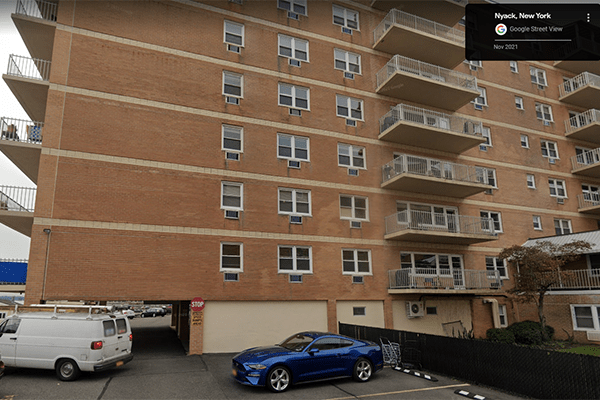|
RCBJ-Audible (Listen For Free)
|
Attorney Dennis Lynch Claims Village Rental Survey Is Defective; Threatens To File Suit On Behalf of Unnamed Landlords If Village Accepts Survey
By Tina Traster
The Nyack Village Board on Thursday will for the second time in two weeks entertain a vote on accepting a rental vacancy survey, which would clear the path to imposing rent stabilization regulations on more than 900 apartments in the Village.
Only rental buildings built before 1974 containing more than 25 rental units would be affected if rent regulations were put in place.
Acceptance of the survey, compiled over several months by Village Administrator Andy Stewart, does not trigger the adoption of rent stabilization laws. Rather, it would lead to a public hearing, tentatively set for October 26, where the village board will consider adopting restrictions on rentals under New York’s Emergency Tenant Protection Act (ETPA), which is itself part of the Housing Stability and Tenant Protection Act of 2019.
The ETPA allows any municipal government in New York State to declare a housing emergency when a specified class of buildings has a vacancy rate of less than 5 percent. In this instance, to avoid burdening smaller mom and pop landlords, Nyack chose only buildings with 25 or more units.
Deputy Mayor Joe Rand said the village capped the survey at buildings with at least 25 rental units. “There are a total of 32 buildings with more than six units totaling 897 units,” said Rand. “We decided that at that level, we would be including a number of non-professional or noninstitutional landlords, not just the giant buildings.”
The survey asked landlords about vacancies in their buildings and the reasons for the vacancies.
At the last meeting, Mayor Don Hammond urged the board to table the issue, which it did. The mayor said Attorney Dennis Lynch has sent in two letters threatening legal action if the survey is adopted, and the board needed more time to examine issues raised in the two letters.
ETPA only applies to buildings built before 1974 but allows municipalities the flexibility to decide which and how many buildings to include, provided the buildings have at least six apartment units.
The ETPA imposes various restrictions on apartments under its umbrella, including having a rent control board determine annual rent increases, requiring minimal levels of building maintenance, and allowing tenants to file complaints of abuses. Tenants would also be entitled to lease renewals at fixed rental adjustments. The ETPA limits a landlord’s ability to raise rents even when a unit becomes vacant and limits a landlord’s ability to recoup investments in improvements to the building and individual units through increased rent.
The survey encompasses nine buildings with more than 900 apartments that collectively reported a vacancy rate of 4.55 percent, making the declaration of an emergency possible under the ETPA. The buildings include 2 Gail Drive, 101 Gedney Street, 36 South Broadway, 84 North Franklin, 197 Sickles Avenue, 153-157 Sixth Avenue, 306-320 High Avenue, 15 Highview Court, and Nyack Plaza.
A statement issued by group of property owners said: “Our position as property owners is that the ETPA’s strict regulations border on punitive measures, disincentivizing property reinvestment. Most of the properties that will be subject to the ETPA are not offending properties, and a significant portion of the units under the purview of the ETPA will benefit people who do not need assistance. A blanket approach is not the solution to protect the Village long-term. We believe there must be a more moderate and equitable step we can take before considering such a drastic measure.”
Lynch, who is representing a handful of unnamed landlords, objected to the survey, saying the Village asked about “Unoccupied” units instead of “Vacant” units – the language the EPTA uses to determine if the 5 percent threshold is met. Lynch argues there are many reasons a unit may be unoccupied and still not qualify as vacant.
However, the language in the survey inquired as to why the unit was unoccupied and gave a non-exclusive list of examples including whether a unit was undergoing renovation, had a tenant moving in at some point, or was uninhabitable.
Lynch also submitted the results of a survey he undertook on his own, demonstrating a vacancy rate above the 5 percent threshold specified under the EPTA. In his survey, he created separate classes of properties based on ownership. In his survey, privately-owned properties had a vacancy rate of over 9 percent and Section 8 properties had a vacancy rate of 6.1 percent.
In July of 2022, the City of Kingston declared a housing emergency, based on its study of local housing conditions and vacancies. Kingston was the first upstate municipality to opt into the Emergency Tenant Protection Act (ETPA).
Earlier this year, Croton on Hudson opted to expand the Emergency Tenant Protection Act in the Village to include all properties with six or more units which were built prior to 1974. Previously, only buildings with 50 or more units were covered by its ETPA regulations.
Efforts to undermine New York’s rent stabilization law were recently rejected by the United States Supreme Court when it declined to consider a challenge by landlords and owners that sought to have the rent stabilization laws declared unconstitutional. The arguments made to the high court charged that rent stabilization laws deprive owners of their property rights, specifically their rights “to exclude, occupy, use, change the use of, and dispose of their property.”















